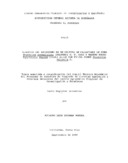Dinámica del nitrógeno en un cultivo en callejones de póro Erythrina poeppigiana (WALPERS) O.F. Cook y madero negro Gliricidia sepium (Jack.) Steud con frijol común Phaseolus vulgaris L
Description
Tesis (Mag Sc)
Abstract
Esta investigación se realizó en el experimento de cultivos en callejones de La Montaña, CATIE, Turrialba, Costa Rica, el cual se estableció en el año de 1982 con el objetivo de evaluar el comportamiento agronómico de cultivo en callejones del poró (Erythrina poeppigiana) y el madero negro (Gliricidia sepium) en asocio con cultivos anuales, que desde 1985, han sido maiz (Zeamays) en rotación con frijol común (Phaseolus vulgar is). El diseño del experimento se incluyeron otros tratamientos a saber: mulches de poró y madero negro, mulch de Gmelina arborea, estiércol de vacuno, todas con una fertilización base anual de PK (40kg ha-1 P205, 80kg ha-1 K20l. Además existen otras parcelas extras con aplicaciones orgánicas (poró y estiércol) sin fertilización. La mitad de todas las parcelas grandes, sin incluirlas extras, recibieron una fertilización con N (25,3 kg ha-1). Consistentemente la producción de ambos cultivos ha sido mayor, cerca de 1 ton.ha-1 en el caso del maíz y alrededor de 600 kg. ha-1 en el de frijol, sobre el control. En años anteriores además se han estudiado diversos parámetros edáficos con el fin de estudiar los cambios inducidos por los cultivos en callejones que puedan estar asociados con los aumentos en la producción.
Se encontró que el principal factor limitante del rendimiento del frijol fue posiblemente el nitrógeno y en forma preliminar se determinó un nivel crítico de requerimiento interno de 4,8 N. Aparentemente la fijación de N2 en el frijol está desempeñando un papel importante en el rendimiento de éste y es de esperarse que también esté afectada por el N disponible a lo largo del desarrollo del cultivo. En un futuro debería estudiarse este aspecto así como la contribución de la fijación de N de los árboles al sistema. This research was conducted in the alley cropping experiment at La Montaña, CATIE, Turrialba, Costa Rica, which was established in 1982 with the objective of evaluating the agronomic performance of alley cropping of poro (Erythrina poeppigiana) and black wood (Gliricidia sepium) in association with annual crops, which since 1985, have been corn (Zeamays) in rotation with common bean (Phaseolus vulgar is). The experimental design included other treatments: poro and black wood mulches, Gmelina arborea mulch, cattle manure, all with an annual base fertilization of PK (40kg ha-1 P205, 80kg ha-1 K20l). In addition there are other extra plots with organic applications (poro and manure) without fertilization. Half of all large plots, excluding the extra plots, received N fertilization (25.3 kg ha-1). Consistently the yield of both crops has been higher, about 1 ton.ha-1 in the case of maize and about 600 kg ha-1 in the case of beans, over the control. In previous years, several edaphic parameters have also been studied in order to study the changes induced by alley cropping that may be associated with yield increases. It was found that the main limiting factor for bean yield was possibly nitrogen and preliminarily a critical internal requirement level of 4.8 N was determined. Apparently N2 fixation in beans is playing an important role in bean yield and it is to be expected that it is also affected by available N throughout the development of the crop. This aspect as well as the contribution of tree N fixation to the system should be studied in the future.
Keywords
Asesor
Ramirez, Carlos
Publisher
Centro Agronómico Tropical de Investigación y Enseñanza (CATIE)
URI (Permanet link to cite or share this item)
https://repositorio.catie.ac.cr/handle/11554/10248Collections
- Tesis [1371]


